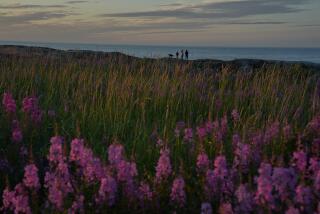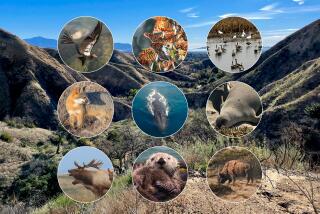Shooting at the Polar Bears That Hunt for Seals
One of the more distinctive experiences on an adventure-nature tour are the photo safaris to witness the annual polar bear migration in the Churchill area of northern Canada. Visitors go out on tundra buggies to see the huge animals.
The bears come to this sub-Arctic area on the shores of Hudson Bay while waiting for the water to freeze so they can go out on the thick ice and hunt for seals.
Like many other adventure outings, travelers should take care to make sure that they are fully prepared for these trips.
“Some travelers underestimate the cold,” says Randy Green of Victor Emmanuel Photo Safaris, one of the companies operating polar bear package tours. “And some people don’t want to invest in clothing they figure they’ll only use once, and they wind up being cold.”
Temperatures drop below freezing during October and early November when the tours take place. Because of the limited season, bookings should be made now for the 1988 season.
Boots, parka, gloves, sweater and a warm hat are needed. Thermal underwear, a scarf and face mask also may come in handy. Pack enough clothing so you can dress with a layered effect.
Close-Up View
Travelers should also understand the tundra buggies. From the safety of these buggies, equipped with five-foot tractor tires and standing 12 feet tall, you can glance down at the bears from very close.
Attracted to the buggies by scents of open sardine cans and other alimentary allures (the bears aren’t supposed to be fed), the bears may amble right up to the buggy and even stand and lean against the vehicle. Picture-taking possibilities are usually excellent.
The heated buggies have windows that can be opened, but it’s not advisable to put your hands and camera outside while taking pictures. Despite their ponderous size, the bears can move with amazing speed.
Take plenty of film. Binoculars also are useful. And patience is required.
“Travelers should realize there’s no guarantee of sighting bears,” says Len Smith, head of Tundra Buggy Tours.
“The weather has a lot to do with the number of bears seen. If the bay freezes over early, many bears may already be gone. And if the weather isn’t too cold, there may be fewer of them.”
Smith also emphasized the importance of understanding local conditions. “Things can break down and not be repaired as quickly as elsewhere, due to the weather and terrain.”
Safety is, of course, another factor. “Some independent travelers want to know where to camp, which isn’t allowed because of the bears,” says Raymond Girardin of the Parks Canadian office in Churchill, which offers exhibits as well as free films about polar bears.
“They haven’t done their homework. And some visitors rent cars and then leave the cars to follow bear tracks. They don’t realize the danger. Some people also ignore the signs posted about not walking in some risky areas.”
Don’t Feed the Bears
Girardin also stressed the need to follow the rule against feeding bears. “The bears that are fed expect to be fed again. If they don’t get fed they get angry, and this can set up confrontations where the bears may be shot.”
Accommodations also represent some questions for many travelers. “Visitors expect to find conditions on the primitive side, and most are pleasantly surprised by the modern facilities,” says Bob Penwarden, owner of the Tundra Inn. “Many guests also bring too much clothing and stuff they never wear.”
The more adventurous, as part of some packages, also may choose to sleep out on the tundra (at an extra cost) on a bunkhouse-on-wheels at the shore of the icy-looking water of the bay. This tundra-based domicile is a combined train-like sleeper attached by a walk-through, open-air caboose to a diner-like eating area.
Be prepared for less comfort than at a standard hotel, if you spend a night or more out on the tundra. There you’re more or less a captive while the bears come by, encouraged by the scent of food.
In their search for scraps, the bears may lean against the bunkhouse.
Feral scenes, on the buggies or at the bunkhouse, can unfurl at any time. We watched a bear next to the bunkhouse chase away an Arctic fox. Moments later a great snowy owl fluttered directly overhead, with the fox obviously in his sights. Shortly afterward, from a greater distance, the same bear struck down the owl, which swooped too low.
You also can capture sights of the bears snoozing, their immense heads beneath their paws, rolling their stomachs against the ground in a scratching effort and foraging along the shoreline, with kelp hanging from their mouths like dark tooth floss.
The stark but not sunless tundra has other attractions besides its wildlife. Sights include snow-dappled granite boulders also marked by blotches of orange lichen; ponds with patches of ice and semi-frozen diaphanous areas showing moss underneath; strange pastel streaks of slush ice sketched like a grounded rainbow on barren shores, and solitary black spruces with sparse branches where the wind hits the trees hardest.
Other Attractions
Churchill also poses some misconceptions for travelers. “Many visitors don’t realize there’s more to do than just go out and see the bears. Some of these attractions are free,” says Joe Kowal, proprietor of the Polar Motel.
For example, the Eskimo Museum features exhibits of ringed seals, walrus, Arctic squirrel and other creatures. One display shows the relative sizes of a bear cub at 15 days, 1 month and 3 months. Admission is free.
As Canada’s only sub-Arctic port--a large grain terminal dominates the skyline--Churchill also has a town center that deserves a look. This complex houses an ice hockey arena, curling rink, swimming pool, cafeteria (with a polar bear slide), children’s playground, etc. You can also have your picture taken against a huge but inanimate polar bear for $3.
Visitors are not allowed inside it, but Churchill also features a Polar Bear Prison just outside town with large cylindrical bear traps standing by the compound. Bears who frequent the city dump--also known as the “Polar Bear Dining Room”--and venture into town are put into jail until the bay freezes over, when they are released.
“We have 20 cells for the bears and two cells for people in town, so you know who the real hell-raisers are around here,” says one local.
Near Churchill also are Ft. Prince of Wales, a forbidding stone fortress built by the Hudson Bay Co. in the 18th Century, and Cape Merry, a secondary bastion protecting the bay. A latter-day high-tech complex, with a rocket range and radar towers once used for research by the United States and Canada, is still much in evidence.
Some travelers also take a one-day excursion to Eskimo Point in the Northwest Territory. This community of about 1,300 allows such glimpses of contemporary Eskimo life as mothers carrying babies in fur hoods while driving three-wheel, all-terrain cycles to and from the supermarket, and wooden houses built atop crossed timbers above the permafrost.
“Visitors should remember to ask before they take pictures of the Eskimos, and not to tip them afterward,” says Don Baker, a guide.
Flights to and from Churchill within the province of Manitoba may be made aboard some vintage aircraft. My flight to Eskimo Point aboard reassuringly named Calm Air was on a DC-3. Because in-flight bags can’t be safely stored by your seat, expect to surrender any carry-ons, which are put into a large net. If you don’t want cameras or other gear jostled, remove them first.
More information about Churchill and the polar bear package tours is available from the Canadian Consulate General, 300 S. Grand Ave., Suite 1000, Los Angeles 90071; (213) 687-7432.
More to Read
Sign up for The Wild
We’ll help you find the best places to hike, bike and run, as well as the perfect silent spots for meditation and yoga.
You may occasionally receive promotional content from the Los Angeles Times.






